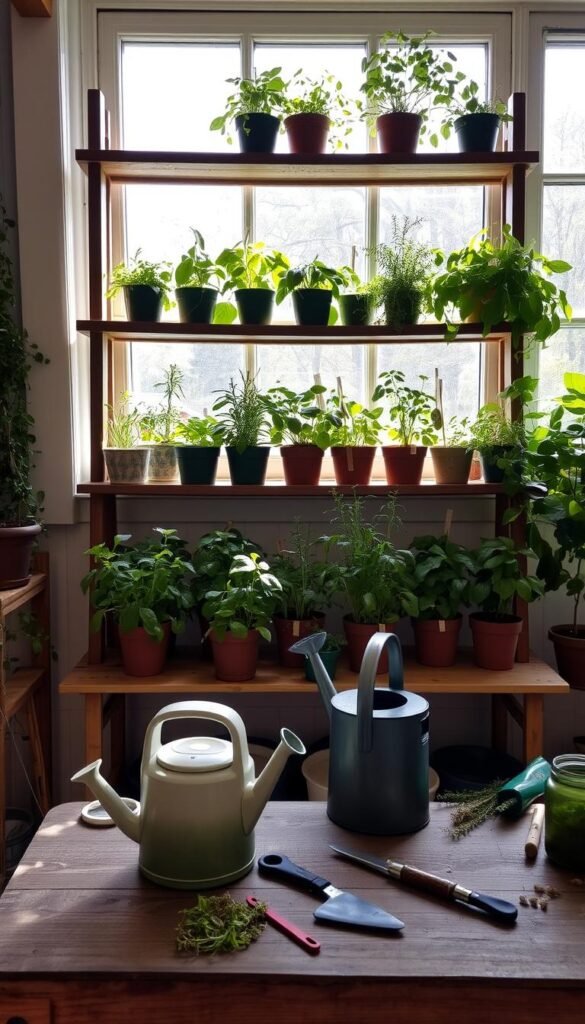Growing fresh flavor boosters in your home sounds simple, right? Those Pinterest-perfect setups might make it look effortless, but cultivating vibrant plants inside requires more than just a sunny spot. Many first-time growers discover this the hard way when their herbs wilt or bolt unexpectedly.
Unlike standard houseplants, culinary varieties thrive under specific conditions. They’ll demand precise light levels, careful watering habits, and proper airflow—details that often surprise newcomers. One wrong move could leave you with limp basil or bitter cilantro.
But here’s the exciting part: gardening success becomes predictable once you learn the rules. This guide reveals the sneaky errors that sabotage most starter setups. You’ll discover why that adorable mason jar might drown your mint and how to keep rosemary from turning into a crispy twig.
Ready to transform your kitchen into a thriving green space? Let’s ensure your leafy companions get exactly what they need—no guesswork required.
Introduction to Your Indoor Herb Garden Journey
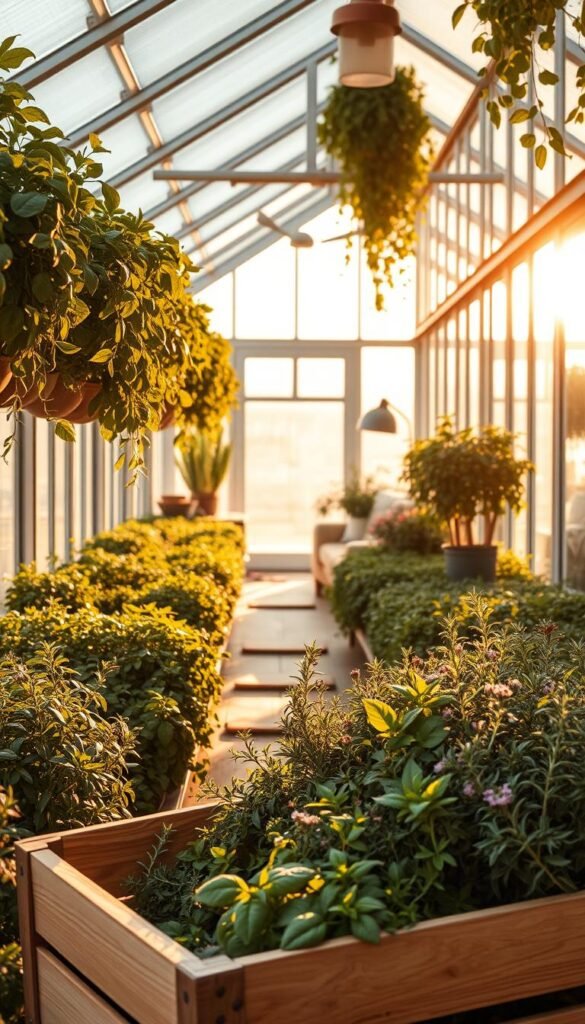
Embarking on your first culinary plant adventure brings immediate rewards. Picture snipping lively basil leaves moments before tossing them into marinara sauce. Envision muddling just-picked mint for mojitos that taste like summer in a glass. This isn’t fantasy—it’s what happens when you master growing herbs at home.
Many assume maintaining plants indoors requires expert skills. Truthfully, success comes from understanding three essentials: light management, hydration balance, and air circulation. Get these right, and you’ll have robust herbs outperforming grocery store options in both flavor and shelf life.
“The difference between store-bought and homegrown? It’s like comparing faded photocopies to vibrant oil paintings.”
Your space doesn’t need perfect southern exposure or high-tech gear. A sunny windowsill and basic containers work wonders. Popular starters like thyme and oregano adapt well to indoor conditions, while basil and parsley demand slightly more attention. Track each variety’s preferences using simple phone reminders or garden journals.
New growers often overlook humidity needs. Cluster pots together to create microclimates, or place them near kitchen sinks. This mimics outdoor dew patterns, keeping leaves supple. Remember: thriving herb garden setups solve problems before they arise. Anticipate needs, and you’ll harvest zestful flavors year-round.
Setting Up the Right Environment for Indoor Herbs
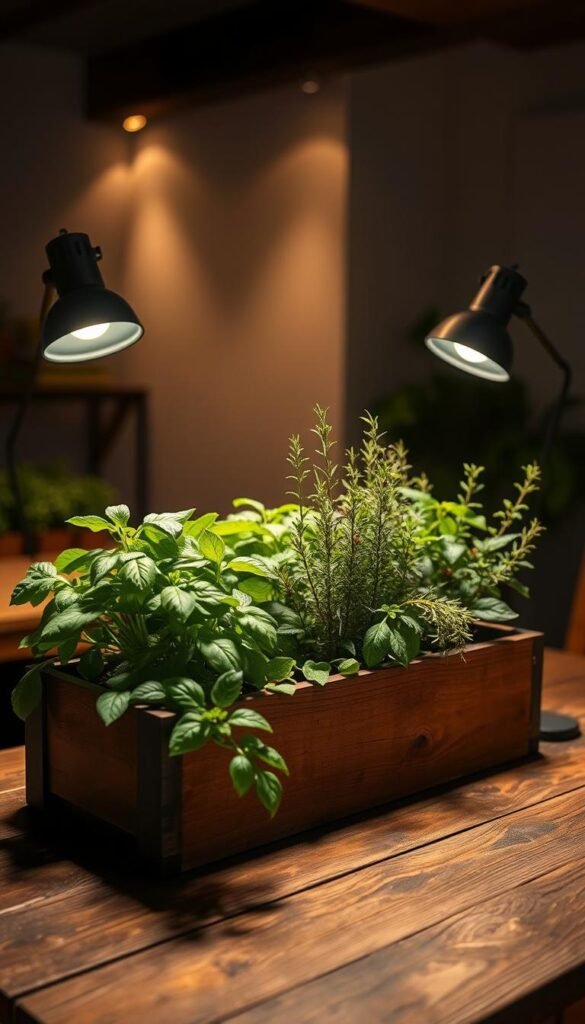
Location dictates survival for your leafy companions. Without strategic placement, even the hardiest varieties struggle to thrive. Let’s create a habitat where flavors intensify and leaves stay vibrant.
Choosing the Perfect Spot
South-facing windows reign supreme for light-hungry varieties like basil and rosemary. These spots deliver 6-8 hours of intense rays—the golden ticket for growth. Rotate pots weekly to prevent lopsided stems reaching for sunshine.
Kitchens often become accidental sanctuaries. Steam from boiling water boosts humidity, while countertop access encourages frequent harvesting. Just ensure your plants aren’t crowding the windowsill—airflow matters as much as brightness.
Optimizing Natural and Artificial Lighting
When winter clouds roll in, LED panels become your secret weapon. Position them 12-14 inches above herbs, mimicking the sun’s spectrum. Set timers for 14-hour daily cycles to maintain consistent light exposure.
“Think of grow lights as vitamin supplements—they fill nutritional gaps when natural resources fall short,” notes urban horticulturist Lila Chen.
Boost existing sunlight with reflective tricks. Tape aluminum foil behind pots or paint walls bright white. These hacks amplify available rays by up to 40%—a game-changer for north-facing spaces.
Watch for temperature extremes near glass panes. Keep foliage 4-6 inches from chilly windows during frosty months. Your herbs will thank you with lush, aromatic leaves instead of frost-nipped disappointment.
Essential Supplies and Container Selection
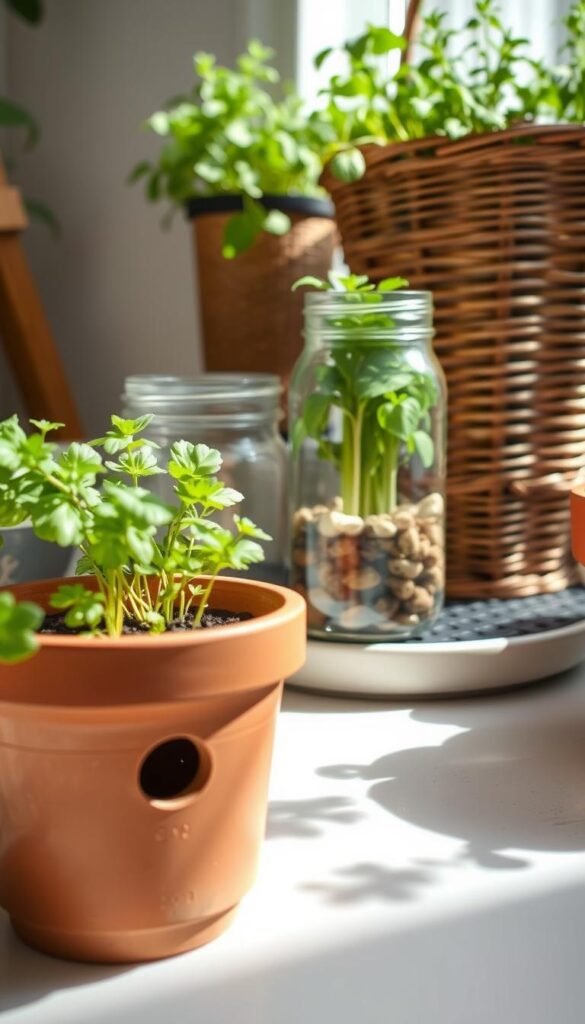
Your leafy companions’ survival starts with what’s beneath them. The right foundation prevents soggy disasters and keeps roots breathing easy. Let’s explore the dynamic duo that keeps plants perky: smart container choices and specialized dirt.
Why Drainage Holes Matter
Those decorative pots might catch your eye, but hidden flaws could drown your greens. Always check for bottom openings—they’re your first defense against root rot. Terra cotta classics work wonders, letting excess moisture escape through porous walls.
Soil Science Simplified
Bagged dirt isn’t all created equal. Reach for mixes labeled “for container gardening”—they contain perlite or vermiculite for better airflow. Mediterranean varieties need extra grit: blend equal parts cactus mix and standard potting soil.
| Container Material | Drainage Capacity | Best For |
|---|---|---|
| Terra Cotta | Excellent | Rosemary, Thyme |
| Glazed Ceramic | Moderate | Basil, Parsley |
| Plastic | Variable | Mint (with saucer) |
Size impacts hydration balance. Go big (6-8″) for thirsty basil, compact (4″) for drought-loving oregano. Pair each pot with a matching saucer to protect surfaces while allowing complete drainage.
“Your plant’s home should work like good rain boots—keep what’s needed, shed the rest.”
Skip garden soil—it turns concrete-like in pots. Premium blends might cost more upfront, but they save money (and heartache) by keeping plants alive longer.
Avoiding Overwatering and Underwatering Pitfalls

Your thumb isn’t the only thing that needs to stay green. Those leafy friends demand smart watering strategies to avoid becoming crispy casualties or swamp victims. Let’s crack the code between parched and drowned roots.
The Finger Test Never Lies
Ditch the calendar reminders. Plunge your index finger 2-3 inches into the soil—if it emerges clean, water thoroughly. Dirt clinging to your skin? Hold off. This simple check accounts for humidity shifts and growth spurts better than any schedule.
Rescue Techniques for Soggy Situations
Yellow leaves waving red flags? Mushy stems scream “root rot ahead!” When overwatering strikes:
- Stop all hydration immediately
- Move pots to bright, airy spots
- Gently aerate soil with a chopstick
“Roots need oxygen as much as water—think of them as tiny scuba divers, not fish,” explains plant pathologist Dr. Elena Torres.
For chronic sogginess, repot using fresh mix with extra perlite. Underwatered plants recover faster—give them a slow, deep drink and trim crispy foliage. Remember: wilted leaves from too much water often mimic drought stress. Always verify moisture levels before acting.
| Overwatering Clues | Underwatering Signs |
|---|---|
| Fungus gnats hovering | Soil pulling from edges |
| Sour-smelling dirt | Brittle stems |
| Black root tips | Rapid leaf drop |
Selecting the Best Herbs for Indoor Cultivation
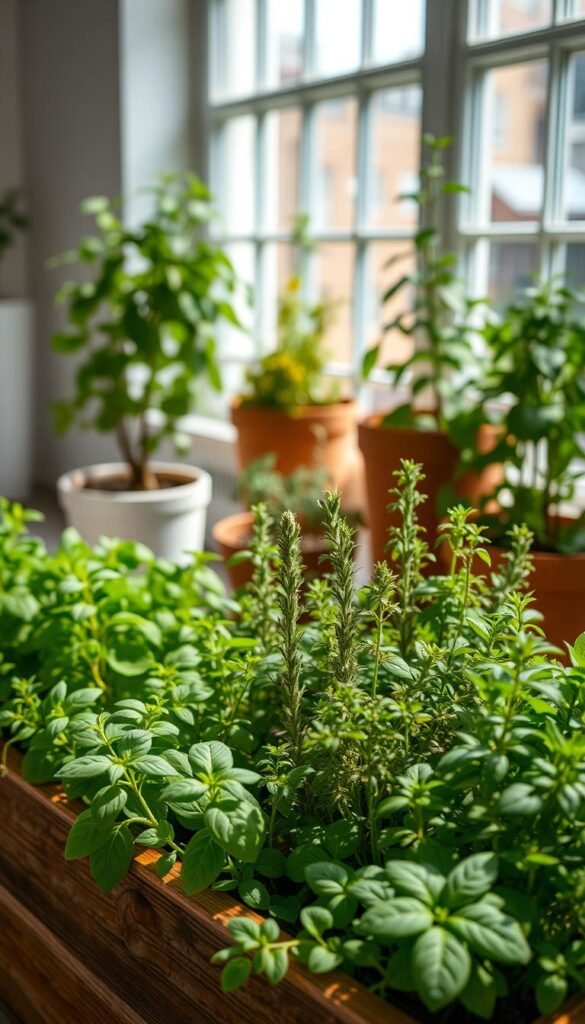
Not all green companions adapt equally to your windowsill. Focus on varieties that naturally match your home’s light and humidity levels. Winning candidates share four traits: manageable height, resilience in imperfect conditions, rapid regrowth after harvesting, and tolerance for stable temperatures.
Herbs That Thrive Indoors
Begin with these low-fuss options:
- Mint – Grows vigorously in solo containers (prevents overcrowding)
- Thyme & Oregano – Flourish with minimal watering and indirect light
- Chives – Regrow quickly after snipping, perfect for omelets
Basil lovers should note: this fan favorite needs daily sunshine. Position pots near south-facing windows for best results. Regular tip-pinching creates bushier plants with higher yields.
| Beginner-Friendly | Wait Until Seasoned |
|---|---|
| Marjoram | Dill |
| Parsley | Lavender |
| Lemongrass | Rosemary |
“Start with forgiving varieties—success breeds confidence to tackle trickier species later,” advises urban gardener Marco Silva.
Match your selections to meals you actually cook. Frequent harvesting keeps herbs productive while ensuring no leaves go to waste. Remember: thriving plants begin with smart species choices.
Small Indoor Herb Garden for Beginners: Top Mistakes to Avoid
Cultivating vibrant flavors at home isn’t just about green thumbs—it’s about sidestepping hidden traps. Many enthusiastic growers accidentally sabotage their efforts by treating leafy companions like ordinary houseplants. Let’s uncover the subtle errors that separate thriving greenery from disappointing harvests.
Common Traps and How to Dodge Them
You might assume all herbs crave daily watering. But Mediterranean varieties like rosemary prefer desert-like conditions. Check soil moisture before reaching for that watering can—parsley and basil enjoy dampness, while thyme thrives in neglect.
Those stylish containers without drainage holes? They’re silent killers. Roots suffocate in standing water, inviting root rot. Always choose pots with multiple openings, and elevate them using pebble trays for airflow.
Light mismatches crush growth potential. Basil demands sunbathing sessions (6+ hours daily), while mint tolerates shade. Rotate pots weekly to prevent lopsided stems stretching toward windows.
Remember: successful gardening means adapting to each plant’s personality. Track progress in a journal, noting what works. Soon, you’ll instinctively avoid pitfalls that once seemed inevitable.
Your kitchen oasis awaits—armed with these tips, watch those delicate sprouts transform into aromatic powerhouses. Fresh flavors and the pride of nurtured life? That’s the real reward.

